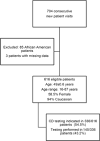Coeliac disease screening is suboptimal in a tertiary gastroenterology setting
- PMID: 28069744
- PMCID: PMC5503792
- DOI: 10.1136/postgradmedj-2016-134005
Coeliac disease screening is suboptimal in a tertiary gastroenterology setting
Abstract
Background and aims: Coeliac disease (CD) is widely prevalent in North America, but case-finding techniques currently used may not be adequate for patient identification. We aimed to determine the adequacy of CD screening in an academic gastroenterology (GI) practice.
Methods: Consecutive initial visits to a tertiary academic GI practice were surveyed over a 3-month period as a fellow-initiated quality improvement project. All electronic records were reviewed to look for indications for CD screening according to published guidelines. The timing of screening was noted (before or after referral), as well as the screening method (serology or biopsy). Data were analysed to compare CD screening practices across subspecialty clinics.
Results: 616 consecutive patients (49±0.6 years, range 16-87 years, 58.5% females, 94% Caucasian) fulfilled inclusion criteria. CD testing was indicated in 336 (54.5%), but performed in only 145 (43.2%). The need for CD screening was highest in luminal GI and inflammatory bowel disease clinics, followed by biliary and hepatology clinics (p<0.0001); CD screening rate was highest in the luminal GI clinic (p=0.002). Of 145 patients screened, 4 patients (2.4%) had serology consistent with CD, of which 2 were proven by duodenal biopsy. Using this proportion, an additional 5 patients might have been diagnosed in 191 untested patients with indications for CD screening.
Conclusions: More than 50% of patients in a tertiary GI clinic have indications for CD screening, but <50% of indicated cases are screened. Case-finding techniques therefore are suboptimal, constituting a gap in patient care and an important target for future quality improvement initiatives.
Published by the BMJ Publishing Group Limited. For permission to use (where not already granted under a licence) please go to http://www.bmj.com/company/products-services/rights-and-licensing/.
Conflict of interest statement
Competing interests: None declared.
Figures


Similar articles
-
Increasing numbers at a specialist coeliac clinic: contribution of serological testing in primary care.Dig Liver Dis. 2005 Dec;37(12):928-33. doi: 10.1016/j.dld.2005.07.011. Epub 2005 Oct 3. Dig Liver Dis. 2005. PMID: 16202673
-
Issues associated with the emergence of coeliac disease in the Asia–Pacific region: a working party report of the World Gastroenterology Organization and the Asian Pacific Association of Gastroenterology.J Gastroenterol Hepatol. 2014 Apr;29(4):666-77. doi: 10.1111/jgh.12514. J Gastroenterol Hepatol. 2014. PMID: 24783246
-
Coeliac disease and the liver: spectrum of liver histology, serology and treatment response at a tertiary referral centre.J Clin Pathol. 2018 May;71(5):412-419. doi: 10.1136/jclinpath-2017-204647. Epub 2017 Sep 29. J Clin Pathol. 2018. PMID: 28970297
-
Recent advances in pediatric celiac disease.Expert Rev Gastroenterol Hepatol. 2017 Jun;11(6):583-592. doi: 10.1080/17474124.2017.1309288. Epub 2017 Mar 28. Expert Rev Gastroenterol Hepatol. 2017. PMID: 28317399 Review.
-
Case-finding in coeliac disease should be intensified.Best Pract Res Clin Gastroenterol. 2005 Jun;19(3):479-86. doi: 10.1016/j.bpg.2005.01.007. Best Pract Res Clin Gastroenterol. 2005. PMID: 15925851 Review.
Cited by
-
Diagnosis and Treatment Patterns in Celiac Disease.Dig Dis Sci. 2019 Aug;64(8):2095-2106. doi: 10.1007/s10620-019-05528-3. Epub 2019 Mar 1. Dig Dis Sci. 2019. PMID: 30820708 Review.
References
-
- Rubio-Tapia A, Ludvigsson JF, Brantner TL, et al. The prevalence of celiac disease in the United States. Am J Gastroenterol. 2012;107:1538–44. quiz 1537, 1545. - PubMed
-
- Catassi C, Kryszak D, Louis-Jacques O, et al. Detection of Celiac disease in primary care: a multicenter case-finding study in North America. Am J Gastroenterol. 2007;102:1454–60. - PubMed
MeSH terms
Grants and funding
LinkOut - more resources
Full Text Sources
Other Literature Sources
Medical
Miscellaneous

